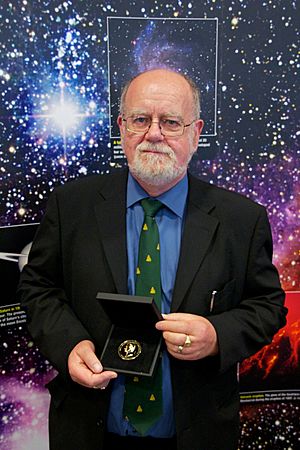John Campbell Brown facts for kids
Quick facts for kids
John Campbell Brown
|
|
|---|---|

John Brown receiving the Gold Medal of the Royal Astronomical Society in 2012
|
|
| Born | 4 February 1947 |
| Died | 16 November 2019 (aged 72) |
| Occupation | |
| Awards |
|
| Website | http://www.johncbrown.org/ |
| Academic career | |
| Fields | Astronomy |
| Institutions |
|
| Academic advisor | Peter Alan Sweet |
| Position held | Astronomer Royal for Scotland (1995–2019) |
John Campbell Brown (born February 4, 1947 – died November 16, 2019) was a famous Scottish astronomer. He mostly studied the Sun, especially its powerful explosions called solar flares. He held important jobs like the Astronomer Royal for Scotland and a professor at the University of Glasgow. He also taught at the University of Edinburgh and the University of Aberdeen.
Contents
About His Life
John Brown was born in Dumbarton, Scotland, in 1947. His love for space began when he was about eight years old. He read a science fiction book by Patrick Moore, a well-known astronomer.
In 1957, when he was 10, he saw Comet Arend–Roland through binoculars. This was the same year the Lovell Telescope opened and Patrick Moore's TV show The Sky at Night started. These events made him even more interested in space. With help from his father, who was an engineer, John built his own telescopes when he was young.
He later married Margaret and had two children. John passed away suddenly at his home on the Isle of Skye on November 16, 2019. He was 72 years old.
His Schooling and Studies
John went to Hartfield Primary in Dumbarton from 1952 to 1958. Then he attended Dumbarton Academy from 1958 to 1964. When he was 16, he started an astronomy club. He even built a 15-centimeter (6-inch) telescope for the club.
He studied physics and astronomy at the University of Glasgow. In 1968, he earned a top-level Bachelor of Science (BSc) degree. While studying, he built more telescopes, one 12-centimeter (5-inch) and another 22-centimeter (9-inch).
In 1973, he earned his Doctor of Philosophy (PhD) degree. His research was about how plasma (a superheated gas) behaves on the Sun. Specifically, he studied X-rays coming from the Sun. In 1984, he received an even higher degree, a Doctor of Science (DSc), for his work in plasma astrophysics.
His Work as an Astronomer
The University of Glasgow hired John as a research assistant in astronomy from 1968 to 1970. He then became a lecturer in 1970, even while still working on his PhD. He was promoted to senior lecturer in 1978 and then to reader in 1980.
From 1983 to 1984, he received a special research grant from the Nuffield Foundation. In 1984, he became a professor of astrophysics. In 1996, he was named the Regius Professor of Astronomy at Glasgow. Starting in 1986, he led Glasgow's astronomy and astrophysics research team.
He also became an honorary professor at the University of Edinburgh in 1996. In 1998, he became an honorary professor at the University of Aberdeen. John taught astronomy to students at all levels, from those just starting university to those working on their advanced degrees.
His Discoveries
John Brown led a research group at the University of Glasgow. They studied and created models of plasma from the Sun and other stars. Plasma is a state of matter, like a gas, but where atoms are broken apart into ions and electrons.
He used information from spacecraft to study high-energy particles from the Sun. He also focused on solar flares, which are huge explosions on the Sun. He is well-known for creating the "Cold Thick Target Model." This model helps explain how X-rays are made during solar flares.
Sharing His Knowledge
As the Astronomer Royal for Scotland, John loved to share his passion for astronomy. He gave many public talks and performances. His goal was to help more people learn about space and its importance in our culture.
He made learning fun by using magic tricks in his presentations. He also used poetry written in the Scots language to explain complex ideas. He was very good at science communication, which means explaining science to everyone.
Awards and Recognitions
In 1984, John was chosen as a fellow of the Royal Society of Edinburgh. This is a special honor for experts in Scotland. In February 1995, he was appointed the 10th Astronomer Royal for Scotland. This is a very important role in Scottish astronomy.
He received the Gold Medal of the Royal Astronomical Society in 2012. This award recognized his important work on solar particles and other contributions to space research. It also honored his efforts to share astronomy with the public. In 2016, he was made an Officer of the Order of the British Empire (OBE). This award was for his great work in promoting astronomy and science education.

